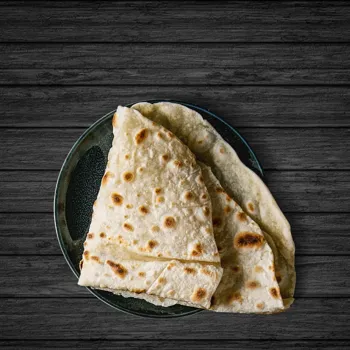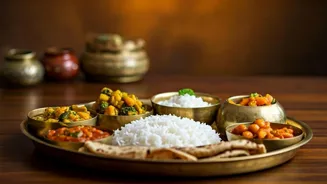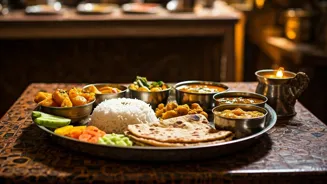Unraveling the Glycemic Index: A Key to Healthier Eating Habits. Dive into how GI impacts your diet and well-being
In the bustling landscape of Indian cuisine, where flavors are bold and carbohydrates often
take center stage, understanding the Glycemic Index (GI) can be a game-changer for your health. The GI is a rating system for foods containing carbohydrates.
It shows how quickly each food affects your blood sugar (glucose) level when that food is eaten on its own. Knowing the GI of different foods can help you make informed choices for better health and sustained energy.
Let's break down what the GI is all about and how you can use it to improve your diet.
Many of us grew up enjoying rice, roti, and an array of sweets, these are staples in Indian households.
But with rising rates of diabetes and obesity, there is a need to look more closely at how these carbohydrates affect our bodies. The GI provides a simple way to understand carbohydrate's effects and make smarter food choices.
By understanding the GI, we can move towards balanced meals that keep us feeling energetic and healthy throughout the day.
The GI scale ranges from 0 to 100. Foods are categorized as low, medium, or high GI.
Low GI foods have a score of 55 or less, medium GI foods range from 56 to 69, and high GI foods are 70 or more. Low GI foods are digested and absorbed slowly, causing a gradual rise in blood sugar levels. High GI foods, on the other hand, cause a rapid spike in blood sugar.
This is why it’s important to eat smart and choose the right foods so your body doesn’t get a shock after meals.
Why is the Glycemic Index Important?
Maintaining stable blood sugar levels is important.
When you eat high GI foods, your body releases a surge of insulin to manage the sudden increase in blood sugar. Over time, frequent spikes and crashes in blood sugar can lead to insulin resistance, a key factor in the development of type 2 diabetes.
Moreover, high GI foods can cause energy crashes, leaving you feeling tired and sluggish after a short burst of energy.
Choosing low GI foods can help to regulate blood sugar levels.
The slow, steady release of glucose provides a more consistent energy supply, which will keep you feeling fuller longer and reduce the risk of overeating. This in turn can also aid in weight management. People who choose low GI foods have better control over their appetite and calorie intake.
Therefore, they support a balanced and healthy diet. For those with diabetes or pre-diabetes, the GI is very important. By opting for low GI carbohydrates, individuals can better control their blood sugar levels and reduce their reliance on medication.
Additionally, understanding the glycemic index isn’t just for managing blood sugar or your weight. It’s about optimizing your overall health and wellbeing. Energy levels, focus, and mood can fluctuate depending on your food.
Low GI diets are often associated with more stable mood and improved mental performance. Therefore, adopting a low GI approach can really improve your overall lifestyle. The GI is your friend in helping you choose foods that provide sustained energy and support your health goals.
Glycemic Index of Common Indian Foods
So, what exactly does this mean for your plate? Let's look at some common Indian foods and their GI values:
Rice
White rice typically has a high GI, around 73. However, brown rice has a lower GI, closer to 68, and basmati rice can be around 58.
Roti
Wheat roti generally has a medium GI. It depends on the type of flour used and how it's processed.

Dals
Most dals like lentils and chickpeas have a low GI, usually below 30.
Fruits
Fruits like apples, oranges, and berries have a low GI, while watermelon and ripe bananas have a higher GI.

Vegetables
Most non-starchy vegetables like spinach, broccoli, and cucumbers have a very low GI.
Sweets
Traditional Indian sweets like gulab jamun and jalebi are typically high in GI.
Tips for Incorporating the Glycemic Index into Your Diet
Now that we know the basics, how can you actually apply this knowledge to your daily diet? Here are some practical tips:
Choose Whole Grains
Opt for brown rice, whole wheat roti, and oats instead of refined grains like white rice and maida. These whole grains are digested slower. They provide a sustained release of energy.
Include Plenty of Fiber
Fiber slows down the absorption of sugar, lowering the overall GI of a meal. Add plenty of vegetables, fruits, and lentils to your dishes.
Combine Foods Wisely
Eating a high GI food along with protein and healthy fats can reduce its overall impact on blood sugar. For example, pair rice with dal.
Portion Control
Even healthy foods can raise blood sugar if eaten in excess. Be mindful of portion sizes to maintain stable glucose levels.
Read Labels
Pay attention to the nutrition labels of packaged foods. Look for the amount of fiber and added sugars. Focus on foods with high fiber and low sugar content.
Making Informed Choices
Understanding the Glycemic Index is not about restricting yourself or following rigid rules. Instead, it’s about making informed choices. It is about creating a balanced diet that supports overall health and well-being.
By focusing on more low GI foods, combining foods wisely, and practicing portion control, you can enjoy your favorite Indian dishes while keeping your blood sugar levels in check. Start small, incorporate these tips gradually, and experience the benefits of a balanced and sustained energy.
Remember this is a journey to lasting health and well being.
The glycemic index can be a useful tool for making better food choices, but it is not the only factor to consider when planning a healthy diet.
Other key factors include the nutrient density of foods, the amount of fiber they contain, and your overall calorie intake. A balanced diet should include a variety of fruits, vegetables, whole grains, and lean protein and healthy fats.
It’s also best to talk to your doctor or a registered dietitian. They can help you create a personalized eating plan. This plan will meet your individual needs and preferences.
Remember, a healthy and balanced diet is not about completely avoiding certain foods.
It’s about incorporating a variety of nutrient-rich options and making conscious choices that support your health goals. Focus on moderation, variety, and mindful eating, and you'll be well on your way to a healthier, happier you and one step closer to understanding the glycemic index.
The Glycemic Index (GI) is a valuable tool for understanding how different foods affect your blood sugar levels. By choosing low GI options and combining foods wisely, you can support stable energy levels, weight management, and overall health.
Remember to incorporate a variety of whole grains, fruits, vegetables, and protein sources into your diet for a balanced and sustainable approach to eating. Start small, stay informed, and enjoy the journey towards a healthier you!
AI Generated Content. Glance/InMobi shall have no liability for the content










